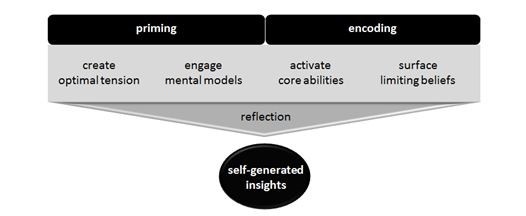My colleagues and I have spent a considerable amount of time and resources rethinking traditional corporate leadership training principles and evaluating assessment techniques used in professional development training programs. As a result, we created the Neural Coding System (NCS). The NCS is a design framework that consists of four cognitive conditions that create the best leadership programs for developing how-to-think learners when the conditions exist together. It is not a step-by-step methodology or series of discrete events. Rather, it is an interconnected system of mental conditions that are created through the artful implementation of various design principles. The underlying philosophy for developing the NCS is that the leadership and development training must cause students to stop and think, reevaluate their mental models, and reach their own insights into how to modify their own thinking or behavior.
The NCS is like a funnel. Simulation training participants are placed in the middle of new situations that are evolving in response to their decisions and actions. This spiral approach, moving between the various conditions, is critical to engaging learners as they evaluate their mental models and seek to resolve gaps. Through trial-and-error and reflective dialogue, this approach allows them to work toward that sudden moment of convergence.

The primary purpose of each of the four cognitive conditions is to come away with self-generated insights. Real learning happens at the moment when a business simulation participant combines knowledge and experiences to create something new, such as a new mental model or belief. I can tell you how a system works, but unless you experiment with it, then you’re merely sharing my perspective of how I think it works. You have your own knowledge and experiences. If you’re going to be effective at making decisions within the system, then you need to construct your own perspective.
When learners work with new material, a small burst of adrenaline is released. This action engages their long-term memory as they build new pathways, or “scaffolding,” to help them make decisions. The more people encounter and overcome their own gaps, the more “scaffolding” they build toward retaining and incorporating information that impacts their performance. At this point, real learning begins, and professional development training programs have the potential to change adverse behavior which results in business transformation.
The point at which learners feel a sudden understanding of a previously perplexing issue is something everyone has experienced. People often call them “insights” or refer to them as “aha” or “eureka” moments. They occur when people sleep, in the middle of a discussion, and in the shower. Little is known about what occurs in the brain before, during, and after an insight, except that there seems to be spikes of electrical and chemical activity. As my colleagues and I explored and learned more about insights through our business simulation participants, we did observe some common conditions that seem to exist prior to an insight. Here’s the kind of typical stream of thought we hear from simulation training participants:
It just happened. I felt that something was wrong, but I could not put my finger on it. It was frustrating, as I believed the answer was right in front of me, but I couldn’t see it. I kept trying different ideas and nothing worked. I remember just before it suddenly hit me, I took a break and I was thinking about something else.
There were some common patterns in the participants’ responses. First, they tended to switch between emotional and cognitive words as they described their state leading up to the insight. Many participants articulated feelings ranging from anger to peace, while also using phrases such as filling gaps, making connections and exploring ideas. Another theme people expressed was the realization that what they knew was incomplete or inaccurate. To find answers, they felt they were spiraling between deep thinking and surface-level thinking.
We also observed in team discussions that participants, without actually using these words, surfaced biases, fears, and flawed mental models. For example, when presented with ethical dilemmas, individuals would quickly jump to a conclusion but then realize those conclusions differed among the team. This led to deep discussions about what they believe and why they believe it. Finally, there seemed to be a common pattern that, just before an insight, simulation training participants temporarily left the problem and did something else. Whether they were getting a cup of coffee or chatting about a different topic, they gave their brains an opportunity to process and re-energize.
These observations, discussions, and extensive research led us to the four conditions of the NCS system that must be present in order to maximize the success of professional development training programs. In my next several posts, I will discuss these conditions and how they work together to create deep learning.
Michael Vaughan is the CEO of The Regis Company, a global provider of custom business simulations and experiential learning programs. Michael is the author of the books The Thinking Effect: Rethinking Thinking to Create Great Leaders and the New Value Worker and The End of Training: How Business Simulations Are Reshaping Business.
